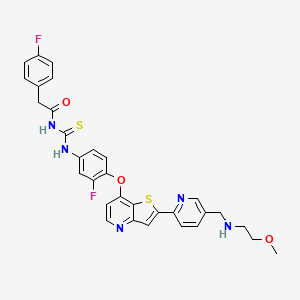Drug Information
Drug (ID: DG01553) and It's Reported Resistant Information
| Name |
Glesatinib
|
||||
|---|---|---|---|---|---|
| Synonyms |
Glesatinib; 936694-12-1; MG90265gly; UNII-7Q29OXD98N; 7Q29OXD98N; MG90265X; MG90265H9; MG90265; N-((3-fluoro-4-((2-(5-(((2-methoxyethyl)amino)methyl)pyridin-2-yl)thieno[3,2-b]pyridin-7-yl)oxy)phenyl)carbamothioyl)-2-(4-fluorophenyl)acetamide; N-[[3-fluoro-4-[2-[5-[(2-methoxyethylamino)methyl]pyridin-2-yl]thieno[3,2-b]pyridin-7-yl]oxyphenyl]carbamothioyl]-2-(4-fluorophenyl)acetamide; Glesatinib free base; Glesatinib [USAN]; Glesatinib (USAN/INN); SCHEMBL106319; GTPL9133; CHEMBL3989914; EX-A4139; MG-90265X; NSC791059; ZINC113139653; DB06302; NSC-791059; SB19664; compound 10a [PMID: 18434145]; NCGC00483925-01; AC-31426; HY-19642; MG-90265; CS-0016148; D11136; A857537; Q27895580; Benzeneacetamide, 4-fluoro-N-(((3-fluoro-4-((2-(5-(((2-methoxyethyl)amino)methyl)-2-pyridinyl)thieno(3,2-b)pyridin-7-yl)oxy)phenyl)amino)thioxomethyl)-; N-((3-fluoro-4-((2-(5-(((2-methoxyethyl)amino)methyl)pyridin-2-yl)thieno[3,2-b]pyridin-7-yl)oxy)phenyl)carbamothioyl)-2-(4-fluorophenyl)acetamid; N-(3-fluoro-4-(2-(5-((2-methoxyethylamino)methyl)pyridin-2-yl)thieno[3,2-b]pyridin-7-yloxy)phenylcarbamothioyl)-2-(4-fluorophenyl)acetamide; N-(3-fluoro-4-(2-(5-((2-methoxyethylamino)methyl)pyridin-2-yl)thieno[3,2-b]pyridine-7-yloxy)phenylcarbamothioyl)-2-(4-fluorophenyl)acetamide
Click to Show/Hide
|
||||
| Structure |

|
||||
| Target | . | NOUNIPROTAC | [1] | ||
| Click to Show/Hide the Molecular Information and External Link(s) of This Drug | |||||
| Formula |
11
|
||||
| IsoSMILES |
COCCNCC1=CN=C(C=C1)C2=CC3=NC=CC(=C3S2)OC4=C(C=C(C=C4)NC(=S)NC(=O)CC5=CC=C(C=C5)F)F
|
||||
| InChI |
InChI=1S/C31H27F2N5O3S2/c1-40-13-12-34-17-20-4-8-24(36-18-20)28-16-25-30(43-28)27(10-11-35-25)41-26-9-7-22(15-23(26)33)37-31(42)38-29(39)14-19-2-5-21(32)6-3-19/h2-11,15-16,18,34H,12-14,17H2,1H3,(H2,37,38,39,42)
|
||||
| InChIKey |
YRCHYHRCBXNYNU-UHFFFAOYSA-N
|
||||
| PubChem CID | |||||
| DrugBank ID | |||||
Type(s) of Resistant Mechanism of This Drug
Drug Resistance Data Categorized by Their Corresponding Diseases
ICD-02: Benign/in-situ/malignant neoplasm
| Drug Sensitivity Data Categorized by Their Corresponding Mechanisms | ||||
|
|
||||
| Key Molecule: Hepatocyte growth factor receptor (MET) | [2] | |||
| Molecule Alteration | Missense mutation | p.Y1003F (c.3008A>T) |
||
| Sensitive Disease | Solid tumour/cancer [ICD-11: 2A00-2F9Z] | |||
| Experimental Note | Revealed Based on the Cell Line Data | |||
| In Vitro Model | Ba/F3 cells | Colon | Homo sapiens (Human) | CVCL_0161 |
| WEHI-3 cells | Peripheral blood | Mus musculus (Mouse) | CVCL_3622 | |
| Hs746T cells | Skeletal muscle | Homo sapiens (Human) | CVCL_0333 | |
| Gp2-293 cells | Fetal kidney | Homo sapiens (Human) | CVCL_WI48 | |
| Experiment for Molecule Alteration |
Direct sequencing assay | |||
| Experiment for Drug Resistance |
CCK-8 assay | |||
| Key Molecule: Hepatocyte growth factor receptor (MET) | [2] | |||
| Molecule Alteration | Missense mutation | p.D1010Y (c.3028G>T) |
||
| Sensitive Disease | Solid tumour/cancer [ICD-11: 2A00-2F9Z] | |||
| Experimental Note | Revealed Based on the Cell Line Data | |||
| In Vitro Model | Ba/F3 cells | Colon | Homo sapiens (Human) | CVCL_0161 |
| WEHI-3 cells | Peripheral blood | Mus musculus (Mouse) | CVCL_3622 | |
| Hs746T cells | Skeletal muscle | Homo sapiens (Human) | CVCL_0333 | |
| Gp2-293 cells | Fetal kidney | Homo sapiens (Human) | CVCL_WI48 | |
| Experiment for Molecule Alteration |
Direct sequencing assay | |||
| Experiment for Drug Resistance |
CCK-8 assay | |||
|
|
||||
| Key Molecule: Hepatocyte growth factor receptor (MET) | [3] | |||
| Molecule Alteration | Missense mutation | p.D1228V (c.3683A>T) |
||
| Sensitive Disease | Solid tumour/cancer [ICD-11: 2A00-2F9Z] | |||
| Experimental Note | Identified from the Human Clinical Data | |||
| In Vitro Model | PC9 cells | Lung | Homo sapiens (Human) | CVCL_B260 |
| 293T cells | Breast | Homo sapiens (Human) | CVCL_0063 | |
| Ba/F3 cells | Colon | Homo sapiens (Human) | CVCL_0161 | |
| Experiment for Molecule Alteration |
Western blotting analysis | |||
| Experiment for Drug Resistance |
MTS assay | |||
| Mechanism Description | There is a patient with metastatic NSCLC with MET-mediated resistance to EGFR TKI who responded to treatment with a type I MET inhibitor, savolitinib, given in combination with a third-generation EGFR inhibitor, osimertinib. The patient then developed acquired resistance mediated by a novel MET kinase domain mutation. | |||
|
|
||||
| Key Molecule: Hepatocyte growth factor receptor (MET) | [4] | |||
| Molecule Alteration | Missense mutation | p.Y1230C (c.3689A>G) |
||
| Sensitive Disease | Solid tumour/cancer [ICD-11: 2A00-2F9Z] | |||
| Experimental Note | Identified from the Human Clinical Data | |||
| Cell Pathway Regulation | MET signaling pathway | Inhibition | hsa04150 | |
| In Vitro Model | NCI-H441 cells | Lung | Homo sapiens (Human) | CVCL_1561 |
| NIH 3T3 cells | Colon | Homo sapiens (Human) | CVCL_0594 | |
| NCI-H596 cells | Lung | Homo sapiens (Human) | CVCL_1571 | |
| Hs746T cells | Skeletal muscle | Homo sapiens (Human) | CVCL_0333 | |
| In Vivo Model | Nu/Nu mouse PDX model | Mus musculus | ||
| Experiment for Molecule Alteration |
Western blotting analysis | |||
| Drug Sensitivity Data Categorized by Their Corresponding Mechanisms | ||||
|
|
||||
| Key Molecule: Hepatocyte growth factor receptor (MET) | [1] | |||
| Molecule Alteration | Missense mutation | p.Y1230C (c.3689A>G) |
||
| Sensitive Disease | Gastric adenocarcinoma [ICD-11: 2B72.0] | |||
| Experimental Note | Identified from the Human Clinical Data | |||
| In Vitro Model | NCI-H441 cells | Lung | Homo sapiens (Human) | CVCL_1561 |
| NIH 3T3 cells | Colon | Homo sapiens (Human) | CVCL_0594 | |
| SNU638 cells | Ascites | Homo sapiens (Human) | CVCL_0102 | |
| NCI-H596 cells | Lung | Homo sapiens (Human) | CVCL_1571 | |
| Hs746T cells | Skeletal muscle | Homo sapiens (Human) | CVCL_0333 | |
| In Vivo Model | Nu/nu mouse xenograft model | Mus musculus | ||
| Experiment for Molecule Alteration |
Western blotting analysis | |||
References
If you find any error in data or bug in web service, please kindly report it to Dr. Sun and Dr. Zhang.
